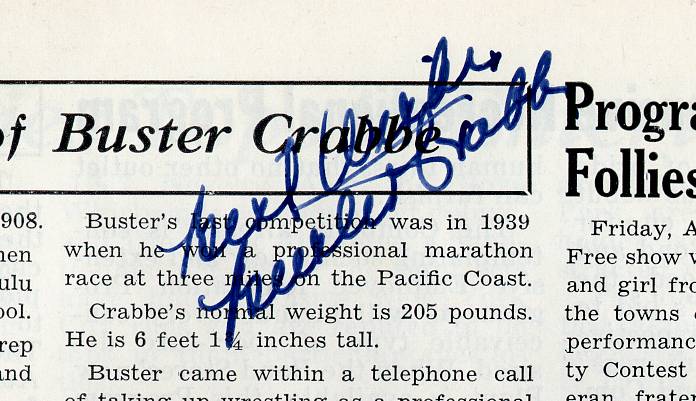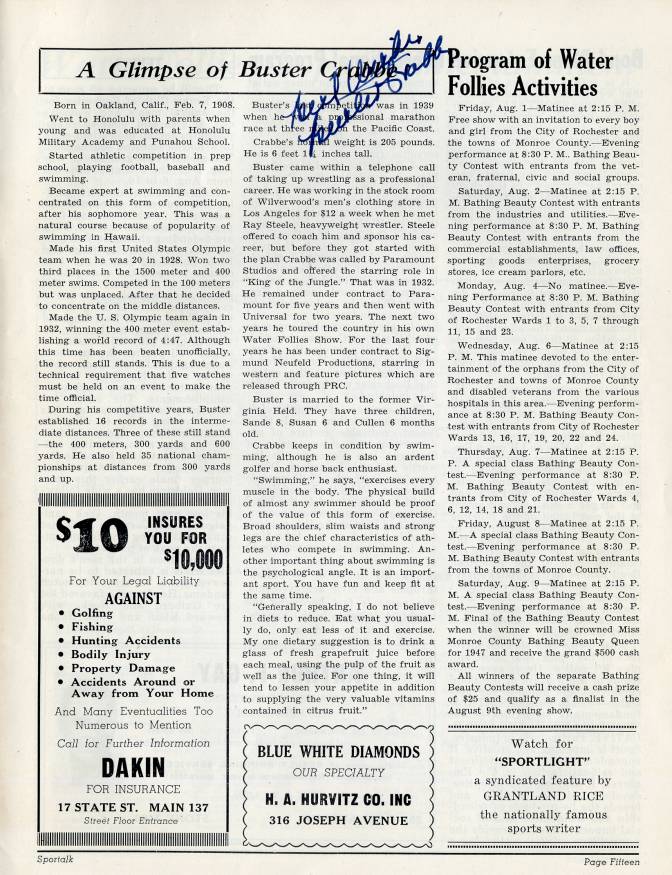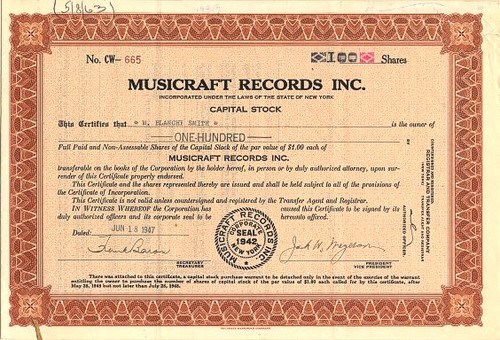Rochester Sportalk Magazine (20 pages) from August 1947. The magazine has an article about signed by Buster Crabbe and he handsigned the page. This item is over 60 years old. 
Signature 
Inside Page Buster Crabbe Born Clarence Linden Crabbe II February 7, 1908 Oakland, California, U.S. Died April 23, 1983 (aged 75) Scottsdale, Arizona, U.S. Clarence Linden "Buster" Crabbe ( February 7, 1908 April 23, 1983) was an American athlete and actor, who starred in a number of popular serials in the 1930s and 1940s. He had the starring role in the popular serial Flash Gordon. He was born as Clarence Linden Crabbe II to Lucy Agnes McNamara (18851959) and Edward Clinton Simmons Crabbe I (1882-?) in Oakland, California. His father was born in Nevada and his paternal grandfather, Clarence Linden Crabbe I (18611941), was born in Hawaii. Buster had a brother, Edward Clinton Simmons Crabbe II (19091972), who was known as "Buddy". In 1910 the family was living in a boarding house in Oakland and Edward senior was working as a real estate broker. As with many Hollywood stars there is a conflict between the birthdate given in his official documents, and the one used in his Hollywood publicity biographies. His birth certificate and his Social Security application both use the birthdate of February 7, 1908. The Encyclopædia Britannica uses an incorrect birthdate based on his Hollywood publicity biography. Raised in Hawaii, he graduated from the Punahou School in Honolulu. He excelled as a swimmer and participated in two Olympic Games: 1928, where he won the bronze medal for the 1,500 metres freestyle, and 1932, where he won the gold medal for the 400 metres freestyle. He attended the University of Southern California, where he was the school's first All-American swimmer (1931) and a 1931 NCAA freestyle titlist. He also became a member of the Sigma Chi Fraternity before graduating from USC in 1931. In 1933 he married his college sweetheart Adah Virginia Held, and gave himself one year to either make it as an actor or start law school at USC. Buster and Virginia remained together until Buster's death in 1983. They had two daughters, Sande and Susan, and a son, Cullen. Sande died of what appeared to be anorexia in 1957, she was 20 years old and weighed only 60 pounds. Crabbe also starred at the Billy Rose's Aquacade at the New York World's Fair in its second year of 1940, replacing Johnny Weismuller. Crabbe's role in the 1933 Tarzan serial Tarzan the Fearless launched a successful career in which he starred in over one hundred movies. It would be the only movie in which Crabbe starred as Tarzan. (The serial was re-edited into a made-for-TV feature in 1964.) In the 1933's King of the Jungle, 1941's Jungle Man, and the 1952 serial King of the Congo, he played generic "jungle man" roles in the Tarzan mode. He also starred in the film Search for Beauty (1934), and his next major role was in 1936 as Flash Gordon in the popular Flash Gordon serial, which he reprised in two sequels, released by Universal in 1938 and 1940. The three serials were later shown extensively on American television during the 1950s and 60s and then edited for release on home video. Other characters he portrayed included Western hero Billy the Kid in 36 films, Buck Rogers, and a brother of his real-life fraternity in the movie musical The Sweetheart of Sigma Chi. In some of his movies he is credited as Larry Crabbe or Larry (Buster) Crabbe. His sidekick in most of his westerns was the actor Al St. John. Crabbe is the only actor who played Tarzan, Flash Gordon, and Buck Rogers -- the top three syndicated comic strip heroes of the 1930s. Crabbe starred in the television series, Captain Gallant of the Foreign Legion (1955 to 1957) as Captain Michael Gallant; the adventure series aired on NBC. His real-life son, Cullen Crabbe, appeared in this show as the character "Cuffy Sanders". He was featured frequently in archival footage in the children's television program, The Gabby Hayes Show. Prior to his playing "Captain Michael Gallant" Crabbe had hosted a local NYC based children's film wraparound television series "The Buster Crabbe Show". The series,which was set against the backdrop of a ranch foreman's bunk house featured Crabbe engaging his viewers in games, stories, craftmaking, hobbies, informational segments and interviews with guest performers and personalities in between reruns of old movie serials, westerns and comedies. "The Buster Crabbe Show" was seen weekday evenings on WOR TV Ch.9 in NYC from Monday March 12, 1951 to Friday October 3, 1952. The series returned to the NYC airways on WJZ TV Ch.7 (now WABC) on Monday September 21, 1953 and was retitled "Buster's Buddies!". The WJZ TV version of the series included a studio audience of kids and became more of a kids' variety show. Despite the addition of the studio audience and Crabbe's personality, "Buster's Buddies!" was not a hit and it was canceled on Friday March 26, 1954. Crabbe made regular television appearances, including one on an episode of the 1979 series Buck Rogers in the 25th Century, in which he played a retired fighter pilot named "Brigadier Gordon" in honor of Flash Gordon. When Rogers (Gil Gerard) praises his flying, Gordon replies "I've been doing that sort of thing since before you were born." Rogers (who was born over 500 years earlier) responds "You think so?" to which Gordon replies "Young man, I know so!" Crabbe had, in fact, been playing "Buck Rogers" since long before Gerard was born. (Info about Mr.Crabbe hosting "The Buster Crabbe Show"/"Buster's Buddies" can be found in "The NYC Kids Shows Round Up" section of TV Party.Com and in "Children's Television: The First Thirty Five Years: Live, Taped And Filmed Shows" by George Woolery, Scarecrow Press, Inc) Crabbe's Hollywood career waned somewhat in the 1950s and 1960s. The ever-industrious Crabbe became a stockbroker and businessman during this period. According to David Ragan's "Movie Stars of the '30s", Crabbe even owned a Southern California swimming pool building company in later years. In the mid-1950s, Crabbe purchased the campus of a small defunct prep school near Onchiota, New York, in the Adirondack Mountains. Renamed Buster Crabbe's Meenahga Lodge the camp advertised itself as swim camp for youngsters age eight to 14, with at least one swim instructor from Hawaii. Using the school's auditorium, along with professionally made costuming and scenery, a couple of musical plays were staged by the campers during the summer under the guidance of several counselors with drama training. Although scheduled to make at least one appearance at the camp each summer, while filming Captain Gallant of the Foreign Legion, he supposedly needed an emergency appendectomy which prevented his attending. During this period of his life, Buster joined the swimming pool company Cascade Industries of Talmagde Road, Edison, New Jersey. In his capacity as Vice President of Sales, promoter and spokesman for Cascade - the world's first "package pool" company - he attended shopping mall openings and fairgrounds combining promotion of his swim camps and Cascade vinyl liner in-ground swimming pools. A pool range was named after him, and pools were sold by "Buster Crabbe Dealers" throughout the eastern seaboard and southern states from 1952 until 1990. By the late 1960s Buster Crabbe "Cascade" pools were available in more than 28 countries worldwide. Buster remained a spokesman for Cascade until his death. The "Cascade Pools" name is still in operation in the US, UK and New Zealand and one US pool company in Missouri is called "Buster Crabbe Pools" while an above-ground pool supplier "Aqua Sports" markets the Buster Crabbe range, so Buster's name lives on in the world of recreational swimming. Though he followed other pursuits, he never stopped acting. From the 1950s forward he appeared in numerous lower budget films. In fact, he appeared in the 1982 feature film, The Comeback Trail one year before his death. Crabbe also appeared in television commercials for Hormel Chili, Icy Hot, and the Magic Mold Bodyshirt, an upper body male girdle of sorts, which purportedly helped in weight loss. Through Icy Hot, he was actively involved in arthritis education. Despite his numerous film and television appearances, he is best remembered today as one of the original action heroes of 1930s and 1940s cinema. In the '50s, two comic book series were published named after him. Eastern Color published 12 issues of Buster Crabbe Comics from 195153, followed by Lev Gleason's The Amazing Adventures of Buster Crabbe for four issues in 1954. History from Wikipedia, The Old Stock Detective, and OldCompany.com (old stock certificate research service)

Signature

Inside Page








